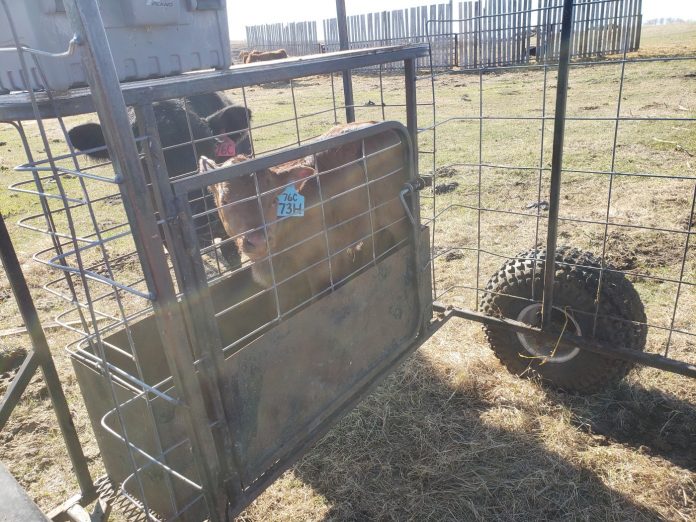The calf was in the back of the catcher, freshly bagged and tagged, while mom quietly followed along behind as I drove them from my pre to post-calving pen. The calves were coming hot and heavy that day — he was number ten of the afternoon— and yet it occurred to me that the whole day had felt oddly…peaceful. As a rancher, that’s usually the sort of thought that should be tempered with a tap on the nearest fence post and a nod to the calving gods, but this time it wasn’t just blind luck — I had to give the real credit to my ATV calf catcher.
We bought the calf catcher about a decade ago, shortly after dad was rolled around on the dirt by some old battleaxe with a double dose of hormones. My brother went to town on her with a Louisville Slugger and was able to buy dad enough time to get out of there before she did any more damage than a sprained ankle, but it certainly left everyone a bit shook up.
In the years since we brought the calf catcher into the game, we’ve yet to have another harrowing experience such as this (obligatory knock on wood) and yet, I’m often surprised at the relatively few producers who have one. I understand that these units are for not built for winter calving, and that the price point is a roadblock for a lot of people, but I believe that anyone who has an ATV and at least 100 head should be prioritizing an ATV calf catcher as their next equipment purchase, and here’s why:
- You can easily catch calves before problems arise
It’s become clear in my ranching experience that one of the biggest factors between a successful day and ending up in the middle of a complete sh*tshow is how quickly I can respond to a problem, and the calf catcher is crucial here. That cow that hasn’t calved yet but is trying to bond up with another calf? Catch the calf and move the pair to another area. That calf you’re suspicious of with the swollen navel? Catch it and have a look. Since it’s no big deal to catch a calf whenever I want to, I find myself taking more preventative measures than I might have otherwise, and consequently avoiding a lot of annoying and potentially costly problems.
2. You can do some pretty wild catches
First off, I want to make the disclaimer that I don’t want any angry emails from people who accidentally break a calf’s leg trying to catch it at 20 mph. That being said, I’ve caught plenty of calves at 20 mph in the past and I’ll probably have to do it again at some point, but there is some technique involved. My brother and I called the maneuver the ‘ol’ pooperscooper’ (don’t ask me why — we were teenagers) and it works by cradling the running calf up against the far inside wall of the catcher while turning the ATV away from the catcher and letting off the throttle. The wall keeps the calf on its feet while slowing it down at the same speed as the ATV. You might wonder why anyone would want to do this, but it’s actually pretty handy if you want to catch a two-week-old twin for an adoption, or maybe you just forgot to tag one and now it’s four days old and ridiculously fast.

3. It completely changes the dynamic between you and your cows
When we were teenagers, my brother and I used to head out after school to go bag and tag calves. We had a quad with a trailer behind — one of us was in charge of bulldogging the calf and putting it in the trailer while the other was known as Batman (wielding the aforementioned Louisville Slugger). Our mindset was that of going into battle, and I’m pretty sure the herd felt it too, as they would immediately go on high alert as soon as we entered the pen. As far as the cattle were concerned, we might as well have been spraying liquid fire while a portable speaker blared ‘Ride of the Valkyries’ (“Ahh, I love the smell of afterbirth in the morning”).
But the calf catcher changed all that. You could almost always catch calves before they got running. You never had to physically grab the calf until you wanted to put it in the rear carrier. And you could always keep the calf between yourself and the cow. I would like to say this changed the cows’ attitudes toward us for the better, but I think it’s more accurate to say that it simply never changed their attitudes for the worse. Over the past decade, as I’ve come closer to a herd that has only ever dealt with the catcher, the cattle have continued to become more laid back about the whole process, to the point where they barely make a noise while I bag and tag the calves and then plod along behind at 5 mph as we move to the post-calving pen. I often find myself looking forward to the bagging and tagging part of my day now. In an odd way, the calf catcher trends toward making itself redundant — in a pinch, I’d be more comfortable working without any protection than I ever would have been before (though I wouldn’t want to make a habit of it as I’m sure they’d be back to their old ways in a few years).
From talking to ranchers who’ve never used one, this is often the part they’re missing about the calf catcher — the short-term goal might be to protect you from a dangerous cow, but the long-term outcome is that, in conjunction with some shrewd culling, you might just find yourself wondering where those dangerous cows disappeared to.










